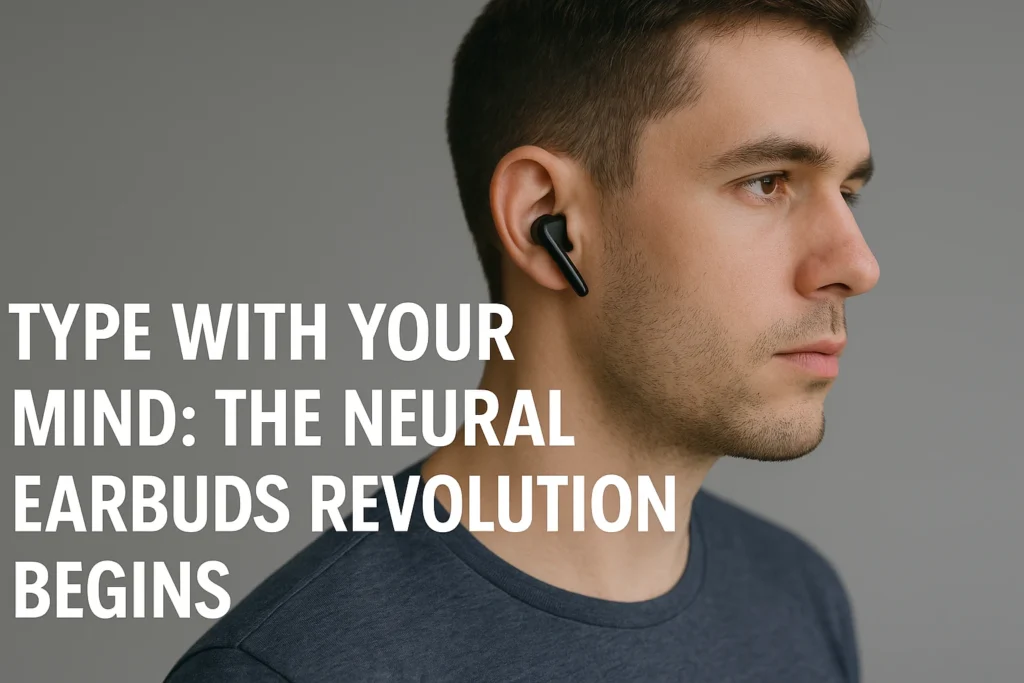Imagine a world where your thoughts become your words, instantly. A world where you can compose a message, control your smart home, or navigate an application without lifting a finger, uttering a sound, or even looking at a screen. For years, this seamless interaction between mind and machine existed only in the realm of science fiction. Today, that future is beginning to unfold, with a pioneering startup leading the charge to bring “thought-to-text” technology directly to your ears. Neural-sensing earbuds are no longer a distant dream; they are a tangible reality, promising to redefine how we interact with our digital world.
This isn’t just another gadget; it’s a revolutionary leap. Think about the countless times you’ve wanted to discreetly reply to a text in a meeting, adjust your playlist on a crowded bus, or control a presentation hands-free. These neural earbuds promise to unlock a new level of freedom and accessibility, transforming everyday interactions into effortless mental commands. The era of silent, invisible control is here, and it’s starting with a simple pair of earbuds.
The Silent Revolution: What are Neural Earbuds?
At its core, a neural earbud is a sophisticated piece of wearable technology that bridges the gap between your brain activity and your digital devices. Unlike traditional headphones that simply play audio, these innovative earbuds are equipped with tiny, highly sensitive sensors. These sensors are designed to detect subtle electrical signals generated by your brain – specifically, the electrical activity associated with thought patterns, facial micro-gestures, and even slight head movements that correspond to intended actions.
Think of it like this: when you think about typing a letter, your brain sends out faint electrical signals. Traditional brain-computer interfaces (BCIs) often require bulky headsets or even invasive surgical implants to pick up these signals. Neural earbuds, however, aim to do this non-invasively, by integrating these advanced sensors directly into a discreet, everyday form factor that fits comfortably in your ear. It’s a remarkable feat of miniaturization and signal processing.
How Thought Becomes Text: The Magic Behind the Scenes
The journey from a thought to a typed message, or an app command, is a complex dance between biology and sophisticated algorithms. Here’s a simplified look at how these neural earbuds work their magic:
- Sensing Brain Signals: The earbuds contain specialized electroencephalography (EEG) sensors, which are designed to make contact with the skin inside or around the ear canal. These sensors pick up the minute electrical impulses generated by the brain’s neurons. While these signals are much smaller than those picked up by full-head EEGs, advancements in sensor technology and signal amplification make them detectable.
- Signal Processing and Filtering: The raw brain signals are often “noisy” – meaning they contain a lot of irrelevant information. A micro-computer within the earbuds, or a connected device like your smartphone, uses advanced algorithms to filter out this noise and isolate the specific patterns associated with intended actions.
- Pattern Recognition and Machine Learning: This is where Artificial Intelligence (AI) plays a crucial role. The system is trained using machine learning models to recognize distinct brain activity patterns corresponding to specific commands. For text input, this might involve recognizing patterns associated with imagining specific finger movements for typing, or even internal speech. For app control, it could be a pattern linked to “selecting” or “scrolling.”
- Translation to Digital Commands: Once a thought pattern is recognized, the system translates it into a digital command. If you’re “thinking to type,” these commands are sent via Bluetooth to your smartphone or computer, appearing as text on your screen. If you’re “thinking to skip a song,” it sends the command to your music app.
This entire process happens in near real-time, creating a seamless, intuitive interaction that feels almost like magic.
More Than Just Messaging: Expanding the Horizon of Control
While thought-to-text messaging is a headline-grabbing application, the potential of neural earbuds extends far beyond simply sending messages. This technology is poised to redefine our interaction with virtually any digital interface:
- App Control: Imagine navigating menus, selecting items, or playing games on your smartphone or smart TV with just a thought.
- Smart Home Integration: Dim the lights, adjust the thermostat, or arm your security system without saying a word or lifting a finger.
- Productivity Enhancement: For professionals, this could mean controlling presentations, silently taking notes, or managing multiple applications simultaneously, leading to unprecedented levels of efficiency.
- Enhanced Accessibility: This technology holds immense promise for individuals with physical limitations or disabilities. It could provide a voice to those unable to speak or offer unprecedented control for those with limited mobility, allowing them to interact with the digital world in ways previously impossible.
- Gaming and VR/AR: Control characters, execute actions, or navigate virtual environments in immersive games and augmented/virtual reality experiences, adding a whole new layer of immersion and intuitive control.
The “invisible user interface” offered by neural earbuds opens up a world of possibilities, making technology more seamless, personal, and accessible than ever before.
The Pioneers: Bringing Mind Control to the Masses
Several innovative companies and research institutions have been diligently working on non-invasive brain-computer interfaces, and the field is heating up. While some prominent players like Neuralink focus on invasive brain implants for specific medical conditions, a distinct wave of startups is dedicated to bringing non-invasive neural control to everyday consumers through wearables like earbuds.
One of the leading names in this emerging space is Naqi Logix. This startup has gained significant attention for its neural earbud technology, even being recognized by major publications and industry awards. Naqi’s approach centers on detecting subtle facial micro-gestures and other neural activities via sensors in the ear, translating them into control commands for various devices. They envision their earbuds as a “third hand,” providing intuitive, hands-free, and voice-free control.
Other companies, like Wisear and Emotiv, are also exploring EEG-enabled earbuds and headsets for various applications, from music control with thoughts to brain performance monitoring. This competitive landscape is driving rapid innovation, pushing the boundaries of what non-invasive neural interfaces can achieve. The focus is increasingly on user-friendly, comfortable devices that seamlessly integrate into daily life.
The Evolution of Control: From Keyboard to Thought
For decades, our primary mode of interaction with computers has been through physical interfaces: keyboards, mice, touchscreens, and more recently, voice commands. Each represented a leap in convenience. The keyboard enabled rapid text entry; the mouse revolutionized graphical interfaces; touchscreens brought intuitive direct manipulation; and voice control offered hands-free interaction.
Neural earbuds represent the next evolutionary step in this human-machine interface. They move beyond physical touch and even audible speech, tapping directly into the electrical signals of the brain. This “thought-to-text” or “thought-to-control” paradigm offers:
- Discretion: Ideal for environments where voice commands are inappropriate or impractical.
- Speed: Potentially faster than typing or complex voice commands for certain tasks.
- Accessibility: A lifeline for those who struggle with traditional input methods.
- Intuition: The ultimate natural interface, where intention directly translates to action.
This evolution signifies a shift towards more seamless, intuitive, and less intrusive ways of interacting with our increasingly connected world.
The Road Ahead: Challenges and Ethical Considerations
While the promise of neural earbuds is immense, the path to widespread adoption is not without its challenges and crucial considerations.
Technical Hurdles:
- Signal Accuracy: Reliably capturing and interpreting subtle brain signals from the ear, especially in diverse environments and for varied users, remains a complex engineering challenge.
- Training and Personalization: Each person’s brain activity patterns are unique. The systems will need robust machine learning algorithms that can quickly learn and adapt to individual users, possibly requiring initial calibration.
- Battery Life and Form Factor: Integrating powerful sensors and processors into tiny, comfortable earbuds while maintaining decent battery life is a significant design hurdle.
- Latency: For real-time control, the delay between a thought and an action needs to be imperceptible to the user.
Ethical and Societal Implications:
- Privacy: What kind of brain data is being collected? How is it stored, protected, and used? The sensitivity of neural data demands robust privacy frameworks and transparent policies.
- Security: How can we ensure that these devices are not vulnerable to hacking or unauthorized access, which could potentially compromise a user’s control or even personal information?
- Cognitive Liberty and Autonomy: As devices delve deeper into our neural activity, questions arise about maintaining individual thought privacy and ensuring that users retain full control over their mental processes and decision-making. UNESCO is actively discussing the ethical implications of neurotechnology, emphasizing the need to protect mental integrity and freedom of thought.
- Accessibility vs. Digital Divide: While promoting accessibility for some, could the advanced nature and cost of such technology exacerbate the digital divide for others?
These are not trivial concerns, and the responsible development and deployment of neural earbuds will require ongoing dialogue among technologists, ethicists, policymakers, and the public.
A Glimpse into Tomorrow: The Future of Human-Machine Interaction
The launch of neural earbuds for thought-to-text messaging is more than just a product release; it’s a profound signal of where human-computer interaction is headed. It signifies a future where our devices understand us not just through our voice or touch, but through our very intentions.
Imagine a future where communication is effortless and universal, breaking down barriers for those who struggle with traditional methods. Picture a world where technology truly anticipates our needs, seamlessly integrating into our lives as an extension of our minds. These neural earbuds are merely the first step on a remarkable journey – a journey that promises to unlock unprecedented levels of human potential and reshape our relationship with the digital world in ways we are only just beginning to comprehend. The revolution, it seems, has already begun, silently, from within.




bjesbp